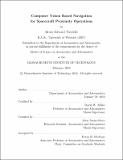Computer vision based navigation for spacecraft proximity operations
Author(s)
Tweddle, Brent Edward
DownloadFull printable version (25.69Mb)
Other Contributors
Massachusetts Institute of Technology. Dept. of Aeronautics and Astronautics.
Advisor
David W. Miller and Alvar Saenz-Otero.
Terms of use
Metadata
Show full item recordAbstract
The use of computer vision for spacecraft relative navigation and proximity operations within an unknown environment is an enabling technology for a number of future commercial and scientific space missions. This thesis presents three first steps towards a larger research initiative to develop and mature these technologies. The first step that is presented is the design and development of a " flight-traceable" upgrade to the Synchronize Position Hold Engage Reorient Experimental Satellites, known as the SPHERES Goggles. This upgrade enables experimental research and maturation of computer vision based navigation technologies on the SPHERES satellites. The second step that is presented is the development of an algorithm for vision based relative spacecraft navigation that uses a fiducial marker with the minimum number of known point correspondences. An experimental evaluation of this algorithm is presented that determines an upper bound on the accuracy and precision of this system. The third step towards vision based relative navigation in an unknown environment is a preliminary investigation into the computational issues associated with high performance embedded computing. The computational characteristics of vision based relative navigation algorithms are discussed along with the requirements that they impose on computational hardware. A trade study is performed which compares a number of dierent commercially available hardware architectures to determine which would provide the best computational performance per unit of electrical power.
Description
Thesis (S.M.)--Massachusetts Institute of Technology, Dept. of Aeronautics and Astronautics, 2010. This electronic version was submitted by the student author. The certified thesis is available in the Institute Archives and Special Collections. Cataloged from student submitted PDF version of thesis. Includes bibliographical references (p. 219-226).
Date issued
2010Department
Massachusetts Institute of Technology. Department of Aeronautics and AstronauticsPublisher
Massachusetts Institute of Technology
Keywords
Aeronautics and Astronautics.